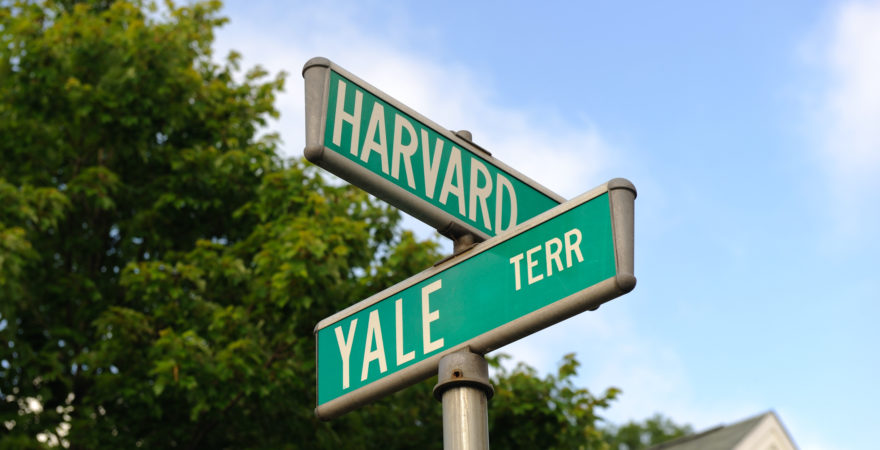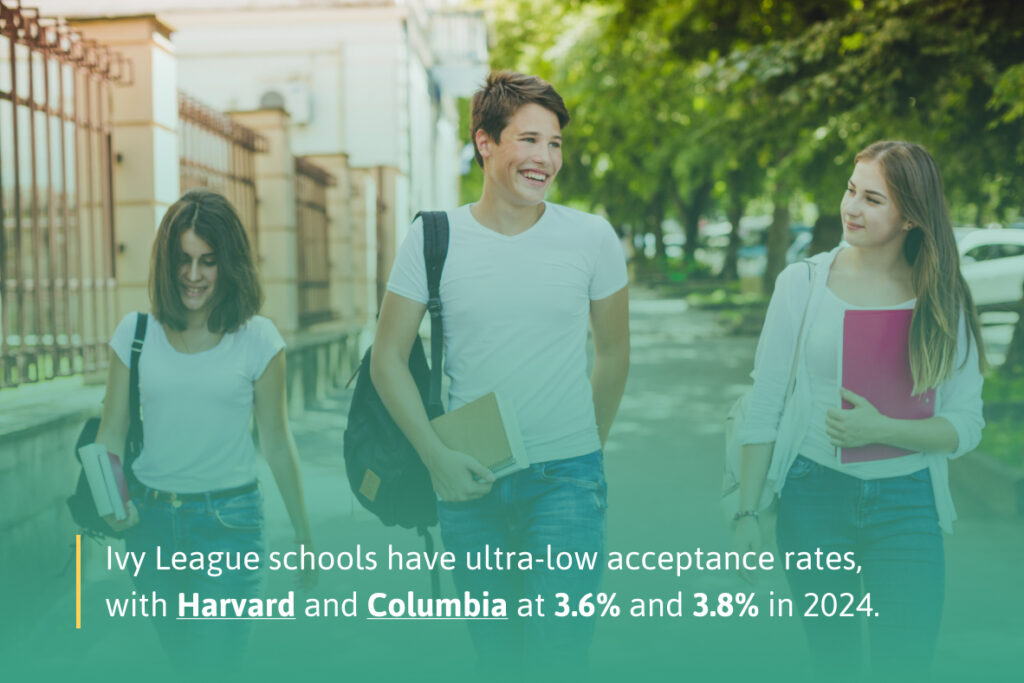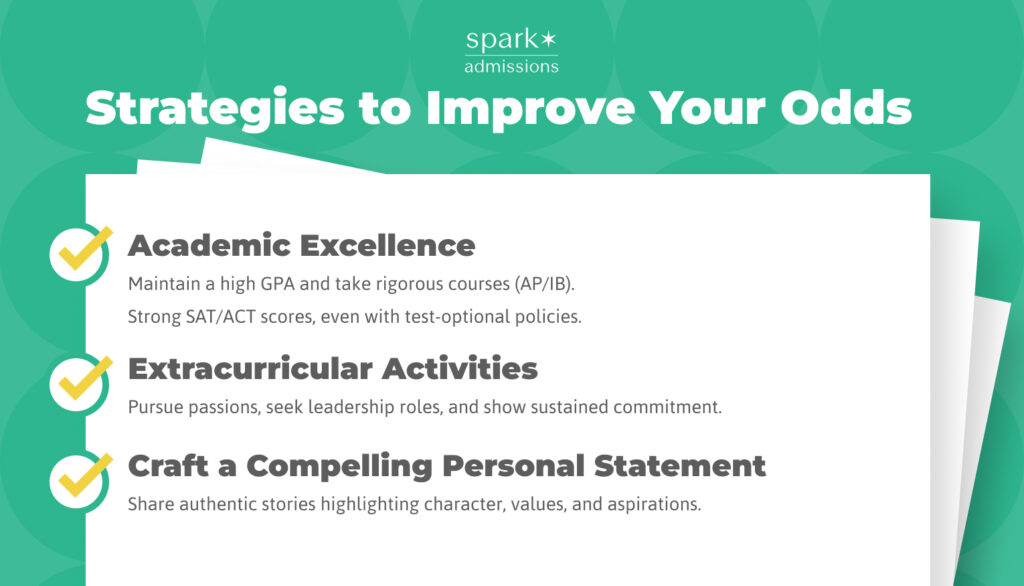
The allure of the Ivy League, comprising eight prestigious universities in the northeastern United States, remains a potent force in the realm of higher education. However, the daunting reality of exceptionally low acceptance rates colors the college admissions landscape for students aspiring to enter these hallowed halls.
In 2024, the average acceptance rate across Ivy League universities dropped to just 5.1%, a sharp decline from 8.9% in 2015—highlighting the skyrocketing competition for a spot in these elite institutions.
Here, we will analyze trends, dissect contributing factors, and offer guidance on navigating the fiercely competitive Ivy League admissions process.
Year-by-Year Comparison of Ivy League Acceptance Rates
A year-by-year comparison of Ivy League acceptance rates reveals a persistent downward trend, underscoring the increasingly competitive nature of these institutions. As the number of applications surges, driven by factors such as growing application pools and test-optional policies, acceptance rates have dwindled, leaving countless students vying for a coveted spot in each incoming class.
It is a fact that the admission rates at Ivy League and other elite universities have dropped significantly in recent years—some steadily, some quite dramatically:
| School | Acceptance Rate by Year* | |||||||
| 2024 | 2021 | 2019 | 2018 | 2015 | 2010 | 2000 | 1990 | |
| Harvard University | 3.6% | 5.0% | 4.5% | 4.6% | 6.2% | 9.3% | 10.9% | 14.3% |
| Columbia University | 3.8% | 5.8% | 5.1% | 5.5% | 6.4% | 11.4% | 14.8% | 32.3% |
| Princeton University | 4.4% | 5.6% | 5.8% | 5.5% | 8.3% | 10.2% | 12.2% | 16.9% |
| Yale University | 4.5% | 6.5% | 5.9% | 6.3% | 7.4% | 7.9% | 16.2% | 19.7% |
| Brown University | 5.2% | 7.6% | 6.6% | 7.0% | 8.7% | 9.3% | 16.2% | ** |
| University of Pennsylvania | 5.4% | 8.9% | 7.4% | 8.4% | 12.3% | 17.7% | 22.8% | 47.0% |
| Dartmouth College | 6.2% | 9.2% | 7.9% | 8.7% | 9.7% | 15.7% | 20.8% | 26.0% |
| Cornell University | 7.8% | 10.7% | 10.6% | 10.3% | 17.8% | 24.7% | 30.9% | 27.9% |
*Data sourced from university websites and news articles. Some data is not available in any reliable form; those years are marked with asterisks (**) in the table.
Now, let’s compare against other top competitive universities in the country:
| School | Acceptance Rate by Year* | |||||||
| 2024 | 2021 | 2019 | 2018 | 2015 | 2010 | 2000 | 1990 | |
| Stanford University | 3.9% | 5.1% | 4.0% | 4.3% | 7.1% | 10.8% | 15.9% | 19.3% |
| University of Chicago | 4.7% | 8.7% | 5.9% | 7.3% | 14.0% | 18.4% | 38.5% | 45.0% |
| Massachusetts Institute of Technology | 4.7% | 6.7% | 6.6% | 6.7% | 7.8% | 11.8% | 14.3% | 22.0% |
| Duke University | 5.1% | 9.2% | 7.4% | 8.6% | 9.4% | 18.9% | 25.4% | ** |
Notable Fluctuations in Recent Years
In recent years, Ivy League acceptance rates have continued their general downward trajectory, with some minor fluctuations. For example, during the pandemic-affected 2021 admissions cycle, schools like Brown University and Columbia University saw temporary increases in acceptance rates, rising from 6.6% to 7.6% and 5.1% to 5.8%, respectively. These upticks can be attributed to factors such as test-optional policies and adjustments in application volumes.
However, by 2024, the trend of tightening selectivity resumed, with rates falling across the board. Cornell University, for instance, dropped from 10.7% in 2021 to 7.8% in 2024, and Columbia saw its rate decline to a record low of 3.8%. These fluctuations reflect shifts in institutional priorities and the lingering effects of the pandemic on applicant pools.
While predicting future acceptance rates remains uncertain, the consistent downward trend indicates that competition for entry into these prestigious institutions will remain as fierce as ever, with even minor increases occurring within an exceptionally selective range.
Projecting Future Acceptance Rates
Projecting future acceptance rates for Ivy League institutions remains speculative, as numerous factors—such as application trends, demographic changes, and shifts in admissions policies—will continue to shape the landscape. However, historical data suggests a clear trajectory: acceptance rates are likely to continue declining as demand for Ivy League education outpaces available spots.
With the number of applicants steadily rising, driven by test-optional policies, global interest, and easier access to application platforms like the Common Application, competition will intensify. For instance, the average Ivy League acceptance rate has dropped by nearly 43% since 2015, signaling a persistent tightening of admissions standards.
Moreover, the growing emphasis on diversity and holistic admissions suggests that Ivy League schools will continue to broaden the applicant pool, making it even harder for students to stand out. The highly selective nature of these institutions not only reflects their prestige but also underscores the value they place on unique personal stories and achievements beyond academics.
Prospective students will face the challenge of securing admission to an Ivy League school, which will require increasingly innovative and strategic approaches. While academic excellence remains critical, attributes like leadership, resilience, and a clear sense of purpose will be pivotal in distinguishing successful candidates. As this trend unfolds, students must adapt to the evolving expectations of college admissions at these elite institutions, underscoring the importance of creativity and authenticity in their applications.

Analyzing Ivy League Acceptance Rates
Ivy League acceptance rates reveal not only fierce competition, but also a complex interplay of factors that admissions committees weigh when evaluating applicants. While standardized test scores and GPAs remain significant, they are just one part of a broader, holistic review process. Admissions teams prioritize intellectual curiosity, leadership potential, and the ability to contribute to a diverse campus community—qualities that often go beyond numbers.
Factors Shaping Selectivity in the Ivy League
Globalization of the Applicant Pool
The globalization of Ivy League admissions has drastically increased competition. Over the last two decades, international applications to Ivy League schools have surged, with institutions like Columbia University admitting students from more than 150 countries. Harvard University reported that 18% of its incoming class of 2028 consisted of international students. This expanding global demand intensifies selectivity, with non-U.S. applicants often competing at even higher rates due to limited slots.
The Impact of Early Decision and Regular Decision on Acceptance Rates
Early Decision programs have become critical in shaping Ivy League admissions. Approximately 50% of spots in some Ivy League schools, such as the University of Pennsylvania, are filled during the Early Decision round. This strategy benefits applicants who demonstrate a strong commitment but reduces availability for Regular Decision applicants. For instance, Brown University’s Early Decision acceptance rate in 2024 was 13.8%, compared to its overall rate of 5.2%.
The choice between Early Decision, Early Action, and Regular Decision can significantly impact acceptance rates at Ivy League institutions. Early Decision, a binding agreement to attend if admitted, often yields higher acceptance rates as it demonstrates a strong commitment to the specific school.
Regular Decision, the non-binding option with a later application deadline, typically results in lower acceptance rates due to the larger pool of applicants. Understanding the nuances, advantages, and potential drawbacks of each application timeline is crucial for aspiring Ivy League students.
Statistical Advantages of Early Decision Applications
Statistical advantages often accompany Early Decision applications to Ivy League institutions, as demonstrated by higher acceptance rates for ED applicants compared to their Regular Decision counterparts. This phenomenon arises from various factors, including the smaller and often self-selected pool of ED applicants and the perception of demonstrated interest conveyed by applying early.
Admissions officers often favor ED applications, as they signify a student’s strong commitment and genuine desire to attend the specific institution. Moreover, the binding nature of ED allows universities to shape their incoming classes more precisely, potentially influencing their willingness to admit a higher proportion of ED applicants.
However, it’s essential to approach ED strategically and only apply if the specific institution represents the absolute top choice, as the binding agreement requires attendance if admitted.
The Role of Yield Management
Yield management is increasingly significant for Ivy League institutions. With acceptance rates as low as 3.6% at Harvard and 3.8% at Columbia in 2024, ensuring that admitted students enroll is vital. Schools carefully assess applicants’ demonstrated interest and alignment with institutional values, which they often gauge through supplemental essays, interviews, and engagement metrics.
Current Trends in Ivy League Admissions
Increased Focus on First-Generation Students
Ivy League schools are making concerted efforts to admit more first-generation college students. As of 2024, nearly 17% of incoming students at Princeton University identified as first-generation, compared to just 10% a decade ago. This emphasis broadens access but adds pressure on these applicants to stand out in an increasingly competitive pool.
The Growing Influence of Demonstrated Interest
Demonstrated interest is becoming a more prominent factor in Ivy League admissions. A 2023 survey revealed that 15.7% of admissions officers at top schools, including Ivy Leagues, view demonstrated interest as “considerably important” in their admissions decisions. Engaging with admissions events, attending virtual tours, and crafting essays that reflect a deep understanding of the institution are now key ways for applicants to distinguish themselves.

Strategies for Improving Your Ivy League Acceptance Odds
Here’s the good news: elite universities are still looking for the things they’ve always liked. They like excellent grades. They like students who take initiative, serve their communities, do well on the SAT or ACT, and are passionate about learning. In some significant ways, the Ivy League admissions process is the same as it always was.
The bad news is it’s easier than ever to get lost in the ever-growing pile of applications. Even if you are what they’re looking for, you should know how schools have changed the college admissions process to make sense of their thousands of entries.
Beyond academics, cultivating a compelling profile through meaningful extracurricular pursuits, showcasing your passions, leadership qualities, and commitment to service, can significantly strengthen your candidacy. Crafting authentic and engaging application essays that provide a window into your aspirations, motivations, and personal growth is equally crucial.
Some particularly talented high school athletes can take a different road into top colleges than others. Coaches at colleges and universities have some say in the college admissions process (known as “recruiting”), so some student athletes are admitted on a coach’s recommendation, even if their profile might not have gotten the attention of admissions as an ordinary applicant. Top colleges do have minimum GPA and SAT/ACT score standards for their recruited athletes, but they tend to be lower than what students need in the regular pool. Recruited athletes are also likely to commit to a school over the summer, meaning they count as early applicants, another thing to keep in mind when looking at those early numbers.
Academic Excellence and Standardized Test Scores
A foundation of academic excellence is non-negotiable in the fiercely competitive process of getting into an Ivy League school. Admissions committees meticulously review transcripts, scrutinizing challenging coursework, stellar grade point averages, and impressive standardized test scores.
Standardized tests, such as the SAT or ACT, provide a standardized measure of academic aptitude, and while some institutions have adopted test-optional policies, strong scores can still bolster an application. Beyond the numbers, conveying a genuine love for learning through insightful essays and recommendations is equally vital. Learn what makes a good SAT score for Ivy League admissions.
- Challenge Yourself Academically: To demonstrate your commitment to academic growth, enroll in the most rigorous courses offered by your high school, such as AP, IB, or honors classes.
- Strive for Consistency: Maintaining a high GPA throughout your high school career demonstrates your work ethic and ability to excel academically over time.
- Prepare for Standardized Tests: Devote ample time to studying and practicing for the SAT or ACT to achieve scores that align with or exceed the average range of admitted students at your target Ivy League schools.
Also, you may have heard about the Dean’s Interest List, a feature of the admissions process at Harvard that emerged during the recent lawsuit against them and has been revealed to be a feature of the college admissions process at other top schools, too. These highly secretive lists refer to applicants the Admissions Office has marked as “of interest to the school” for one reason or another. These applicants might be athletes, legacies, children of major donors, or individuals who otherwise have a connection to the university and its faculty or administration. The admission rate for students who can get a spot on these coveted lists is significantly higher than that for either Early or Regular Decision applicants. Not all schools consider legacy status when evaluating a prospective applicant, so it’s important to keep track of which schools do.
Extracurricular Activities and Leadership Roles
Extracurricular activities provide a platform to showcase your passions, talents, and commitment beyond the classroom. Ivy League institutions seek students who will enrich their campus community, and participation in activities that resonate with your interests demonstrates your well-rounded personality and dedication.
Leadership roles within these extracurricular endeavors are highly valued, as they highlight your initiative, ability to inspire others, and commitment to making a meaningful impact.
- Pursue Your Passions: To showcase your enthusiasm and dedication, engage in activities that genuinely excite you, such as athletics, arts, music, debate, or community service.
- Seek Leadership Opportunities: Take initiative within your chosen activities to assume leadership roles, demonstrating your ability to motivate others, work effectively in teams, and make tangible contributions.
- Showcase Commitment and Impact: Focus on a few key extracurricular areas where you can demonstrate sustained involvement, growth over time, and tangible accomplishments.
Crafting a Compelling Personal Statement
A compelling personal statement is paramount in distinguishing yourself from the pool of academically gifted Ivy League applicants. This essay offers a unique opportunity to share your story, articulate your aspirations, connect with the reader on a personal level, and demonstrate why you belong as part of the Ivy League community.
Authenticity is key; delve beyond generic achievements and share anecdotes that reveal your character, values, and motivations. Highlight experiences that have shaped your perspective, fueled your intellectual curiosity, or ignited a passion for making a difference.
Remember, the personal statement is not merely a summary of your accomplishments but rather an opportunity to showcase your unique voice, personality, and potential contributions to the vibrant intellectual tapestry of an Ivy League institution.

Who Gets In? Admissions to the Ivy League
There’s a (mis)perception that elite schools admit a large number of students from minority racial backgrounds and lower socioeconomic standing, perhaps “instead of” students with higher grades and test scores. While it is true that most selective schools treat applications from disadvantaged high school students holistically—as they do all applications—to understand how sociological barriers may have impacted students’ academic profiles, the overall data show that universities like Yale and Harvard still admit a disproportionate number of white students from affluent backgrounds, compared to the demographic average of the nation.
Understanding Ivy League acceptance rates involves analyzing various factors such as academic achievements, extracurricular involvement, and the impact of Early Decision applications. By focusing on attaining academic excellence, showcasing leadership skills, and crafting a compelling personal statement, you can enhance your chances of gaining admission to these prestigious universities. Stay abreast of current trends in Ivy League admissions to strategize effectively for your application process. Remember, the journey to Ivy League acceptance is competitive, but with dedication and a well-rounded approach, your aspirations can turn into reality.
At the end of the day, the question for you is: how can you stand out in this crowd? We’re here to help! Check out our other pages to learn more about how teaming up with an Ivy League admissions consultant can help you beat the odds and gain admission to the school of your dreams.


